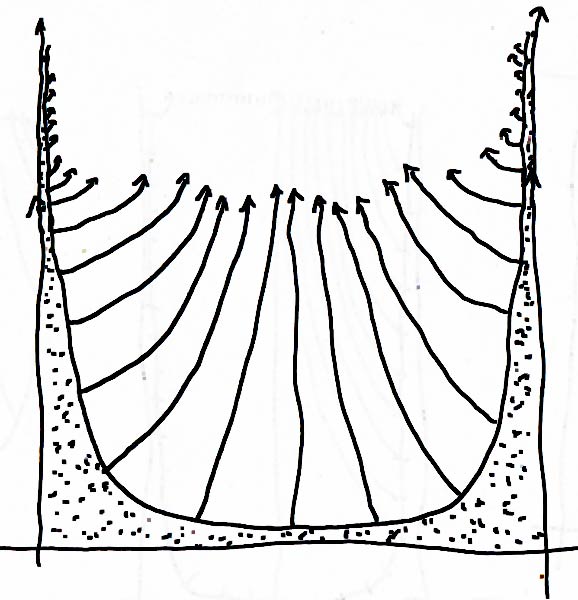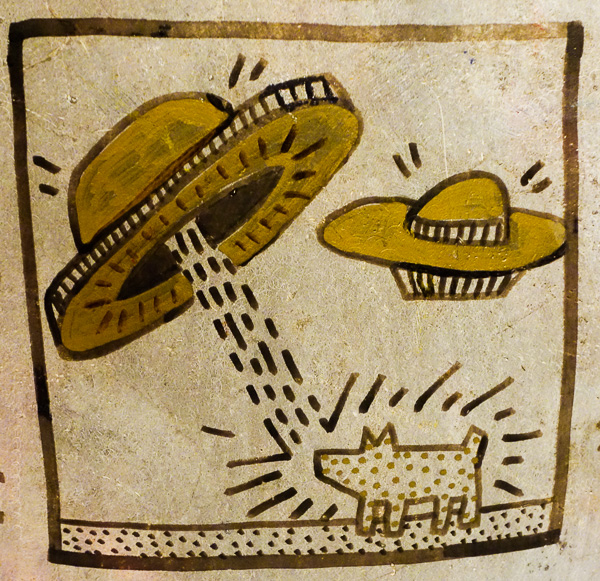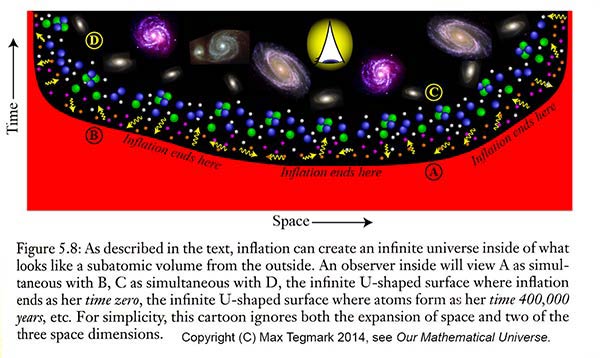As I mentioned in “Against Recurrence #1” contemporary cosmologists are inclined to say that the space of our universe is infinite. The whole infinite space was effectively filled with a giant flash about four billion years ago.

In 2008, I was interested in a fairly simple model for this called the cyclic universe. Invented by Paul Steinhardt and Neil Turok, it basically postulates a pair of “branes” that oscillate back and forth, periodically passing through each other and thereby filling all of infinite space with a revivifying and reseeding flash. I posted about it several times, and I even discussed it on the phone with Steinhardt.
Eventually, Bruce Sterling and I even wrote a story based on this idea, it was called “Colliding Branes,” and you can read it online. I sent the story to Steinhardt, but he never wrote me back. I guess he was like, “That is not what I meant at all. That is not it at all.”
Now, in 2015, the cyclic universe model seems to have lost ground to the eternal inflation model that I mentioned the other day in “Against Recurrence #1“. This is the idea that one speck of supermatter expands forever, and that successive regions of space “boil off” from the expanding speck, creating a diagram like the one I found in Max Tegmark’s book—I’m showing it here again, and I’ve added a drawing below.

We’re looking at a spacetime diagram, with time running up forever. The idea seems to be that the one little scrap of “starter dough” has two regions that last forever, shown on the left and the right. The “steaming off” galaxies from the starter dough keep endlessly appearing, each with its own timeline that in turn bends up and runs toward eternity. The poor saps in these galaxies (us) imagine that all of them arose at the same time. The other tricky angle is that that finite-looking space inside the “U” between the two borderlines—that space is unbounded, and in fact infinite.
Back in the ‘50s and ‘60s some cosmologists used the word ylem to refer to the starter dough, so I might use that word here too.
Really this drawing should be shaped more like a V than like a rectangle, the idea being that the horizontal dimension is tiny and finite at the bottom, and it opens up endlessly as we run up the pseudotimeline of the ylem blobby. But, as I say, we see that whole U-line as being the one moment of universal creation of an endless world.

And it’s the quantum fluctuations and wriggles in the starter dough that are seeding the infinitely many galaxy births. In other words, the starter dough contains an infinite amount of information.
What gets me attention is that the eternal inflation model is in effect ascribing infinite complexity to that finitely large initial glob of ylem. This tends to support a view of mine which is, these days, complete out of favor with scientists. That is, I advocate the doctrine of “infinities in the small.”

The current philosophy of science is dominated by the pernicious and unreasonable doctrine that space and time are quantized into pixels. But why should we believe this? It’s like the situation where, to a hammer, everything looks like a nail. We use computers, so to us everything looks like a computer screen.
Quantum mechanics is only one stage of our ongoing exploration of the world. Inevitably we’ll move beyond it, onwards into the subaether, the subdimensions, the ultra particles, the rootless tree of matter, the absolute continuum, whatever. If the universe is infinitely large, why can’t we have infinities in the small? If the primordial ylem contains infinite information, then why shouldn’t the tip of my finger?

Regarding physical infinities, here are two relevant quotes from Georg Cantor, the founder of set theory, which is the mathematical study of infinity.
The fear of infinity is a form of myopia that destroys the possibility of seeing the actual infinite, even though it in its highest form has created and sustains us, and in its secondary transfinite forms occurs all around us and even inhabits our minds.
The actual infinite arises in three contexts: first when it is realized in the most complete form, in a fully independent otherworldly being, in Deo, where I call it the Absolute Infinite or simply Absolute; second when it occurs in the contingent, created world; third when the mind grasps it in abstracto as a mathematical magnitude, number or order type.
—-Georg Cantor, writing in the 1880s, passages translated by me for my nonfiction book, Infinity and the Mind.
.

Okay, fine. At this point you might wonder why I’m so obsessed with arguing for infinities in the small. Well, my issue, once again, is that, if we are going to have an infinite space with infinitely many planets, I don’t want to frikkin’ squander this endless grandeur on lame-butt wallpaper-like repetitions of the same things over and over and over. I don’t want the cosmos to be sit-com reruns. I want our infinite space to be filled with infinitely many worlds with no two alike! And if each of us is in fact an infinite being, then it’s clear that there’s no need to repeat. QED.

And now we get to my real underlying purpose in these posts. I’m working on a novel called Million Mile Roadtrip. My teen characters are in a car on an alternate universe that has the form of an infinite more-or-less flat plain (albeit with mountains and seas). The plain is divided into basins about ten thousand miles across. Each basin is, in effect, like the surface of a new and different populated planet, no two the same.
My question is this: what is the process that seeds a universe with an endless number of different worlds? Where does all that tasty info come from?
I’m not at all into the defeatist shoulder-shrugging non-explanation along the lines of, “Well, there’s infinitely many planets, and each one is completely random, the product of quantum coin flips so pretty much everything possible has to crop up.” This multiversal line of thought is currently much in favor, but I don’t like it. I want some frikkin’ answers, man!
Although it’s not quite relevant, I’ll quote from an 1880s essay by Hermann Schubert, attacking the then popular spiritualist notion that there are ghosts which live in the fourth dimension. Schubert winds up his essay with these stirring words:
The high eminence on which the knowledge and civilization of humanity now stands was not reached by the thoughtless employment of fanciful ideas, nor by recourse to a four-dimensional world, but by hard, serious labor, and slow, unceasing research. Let all men of science, therefore, band themselves together and oppose a solid front to methods that explain everything that is now mysterious to us by the interference of independent spirits.
Great rhetoric. To make it fit what I’m talking about in this post, I’d need to change “independent spirits” to “unseen, endlessly spinning roulette wheels.”

What if we say that there is only one universe, and its infinite, and it’s not random at all, no, it’s filled with lovely, beautiful forms such as might be crafted by an infinite, omnipotent, eternal Mind? What if our universe is a supreme work of art? [Religion alert! Angry buzzers! Flashing red light!]

But wait. What if the supreme mind isn’t some distant, bossy God. What if the Mind is omnipresent, an ocean in which we swim, a great dance in which, by thinking our own thoughts, we participate. What if you’re infinite—and you made the world? Look within yourself. Could it really be otherwise?

Okay, fine, I enjoy writing mystical effusions, they get me high. But then I like to try and tighten it down a little more. What would be a reasonable process by which some great Designer might come up with endlessly many cool planets without having to comb through a superexponential amount of junk?
My Twitter follower R. R. Mutt reminded me of a recent article in the New Yorker about a guy, Sean Murray, who’s using what they call a “procedural algorithm” to generate endless numbers of planets for the artificial world of a forthcoming videogame, No Man’s Sky.
The idea is to come up with an algorithm that accepts some random parameters, and use that for creating your endlessly many populated planets. The desiderata are that (a) the algorithm produces something fairly reasonable-looking no matter what the parameters are, and (b) the algorithm’s parameter space contains many bifurcations—meaning that different parameters can produce totally different-looking worlds, and (c) the parameter space’s basins of attraction have a fractal quality, meaning that, by digging down into more and more precisely specified parameter sets, you can obtain infinitely many interesting and distinct outputs.

The DNA in our cells is, in a way, a parameter set for the procedural algorithm of life on Earth. And the algorithm is very richly sensitive to the parameters.
I once heard the biologist Richard Dawkins talk about the pre-Cambrian explosion of new species being sparked by something that somehow enhanced the “evolvability” of the organisms.
So as universal gods, we’d need something like DNA, but better—for spinning out an endless range of cool worlds.

And that’s all I’ve got today!











June 2nd, 2015 at 11:24 am
“…what is the process that seeds a universe with an endless number of different worlds? Where does all that tasty info come from?”
I think what we see as “tasty info” might be some second order or meta information that emerges from the workings of the universal substrate and not the first order information as you (might) imply. That gets us to a place were a set of rules can generate an infinite set of results.
If there are a handful of “physics properties” that for the rules of some uber quantum computational engine and the “execution” of that engine produces results that we see (or results in something else that computes results that we see ad infinitum)), then you get a potentially infinite variety of rules from some finite subset of that info that booted the universe in the first place.
A more mundane example from a-life/artificial world software, you can have a world generator app that will churn out as many different planets/geographies/environments as you care to make (e.g. Minecraft for the most mundane example I can think of).
So the tasty info may have been generated by some underlying system executing some rules you don’t get to see. It makes things look infinite, but you’re seeing the results of the proverbial million monkeys and not an endless cosmic Turing tape that you’re seeking across.
June 2nd, 2015 at 5:11 pm
I don’t like the idea of infinite copies either, and I’d much rather have a universe of infinite variety, but when I think about it I get stuck on what might be called “the argument from camera”. You could hop on your spaceship with a digital camera (or holographic recorder) and visit world after world taking photos of the local inhabitants and landscapes and, whatever the resolution, you’d only ever have a finite number of possible images. Maybe that doesn’t put a limit on what’s possible, but possibly limits what we can comprehend.
June 3rd, 2015 at 4:09 am
There seem to be two major themes for 3d space, using x,y,andz axes that are linear, or x,y,and z that are planar, but always at right angles to one another. Always trying for the “I’m so original” dance, I proposed that the 3 right-anglee opposed dimensions might be a Golden Spiral, which is more than 2 but less than three dimensions. Imagine three such spirals at right angle intersections…what would the shape be that would be described by such a crossing? Would a cross-sectional slice of that shape be the spiral, continually reiterating itself as it seems to do? See those spirals manifest themselve at every scale…. tt Then, I imagined myself standing on planet CueBall, the surface of which appears flat, and which dwindles out to a horizon line that appears straight, yet is a closed curve, and which contains both the solid, opaque universe of the World, and the transparent, dark universe f the Firmament. Both are bounded by the horizon line of the World….but if you travel out into deep space, where then is the Horizon Line of tthe Universe? On th World, the horizon is boundary to both aspects if the visible Universe, but in deep space, the Universemust surround it’s own horizon. Thuse, we find “black holes”(The actul reality or which I am still divided about) An important aspect f these structures is the Frame Dragging, which can be viewed as a property f the Universe that creates th appearance of a horizon line wrapped around it, and the closer to the “event horizon”(Lovely phrase, that) a space ship proceeds, the deeper into the frame-dragged vanishing point perspective it gets. The less attached to outer temporal duration it is, though from its POV the universe appears unchanged and the ship gets no closer to the Zeno Point. The reason why there appears to be a transcendentally massive Thing in there is because if you look down tthe throat of Infinity, there is always infinitely more Stuff superimposed upon itself by the vanishing point, even tho there Is No Vnishing Point, only an Infinitely Deep Wormhole-like tube with a spiral cross section and all of futurity in it. This is the Great Attractor tht is sucking all the matter in the Universe into itself, or,rather, because there is no Arrow of Time proceeding out of it toward us, the matter in the Known Cosmos is being hammered down this Vanihing Point neck of the Universe from behind…by the “Dark Energy?”
June 3rd, 2015 at 5:15 am
And, in the effort of answering the question of the origin of the incredible complexity and intricate abundanvce of detail in the Universe, I fall back on my Answer or Everything, which is Magic. There are Two aspects of existance, The Mechanical and the Vital. Science derives from the Mechanical, and Metaphysics,Religion,Spirituality, Philosophy, Mathematics and Thought derive from the Magical. The Name of God (The Ain-Soph, the Word, the Logos, etc) is the Alpha and Omega of the Magical. I have experienced too many Magical events in the course of my life to disregard the Magical, even though it is impossible to Prove a Magical Relity using the logic of Science. For example…..The Pauli Exclusion Principle: Even though the vocabulary of words that can be used to define the PEP is bounded and even numerable, yet No Two Physicists will use the sme exact wording to define the PEP, no matter how hard they try. This is the Magical PEP that is the Platonic Ideal of the PEP you read about in Quantum Mechanics. Science is a Subset of Magic. One of the Foundation Concepts of Magic is the “In Imago Dei”, the concept that humans have no True Name, unlike Angels, Demons, “Deities” and other such Entities. Humans share their True Name with God, and this is the Source of Magical Power, the Name, which is The Name that Cannot Be Spoken(Not because t is forbidden, bt rather, try and say every name in a LAPhone Book in one syllabic vocalization…) The Name is the Algorhythm of Algorhythms, the Mathematics behind Math, the Word that has all Words within It, and so on. The Name is the Source of Vital Flux, which gives rise to the Observer(The All Seing Eye, which is the Eye of Man, because God does not “exist”(Transcends existance) The Garden of Eden contained All Things in Potentia; when The Ancient of days cast Adam and Eve from Eden, He gave a duty, a resposibility to Adam, Eve, and their offspring, whch was to gie Names to All things, and to continue the Work of Creation. We were given the Key to Eternity, the Key that unloks the True Name, and all of us do it, whether we are aware of it or not. Whenever my Julie dances, plays her drum, sings, sews, draws or writes, she is drawing upon the Word that is her birthright. Whenever you do Math, paint, write, think, thwim or meditate, you can do these things because that Word defines the flow of VitalFlux that is you and is not you. Every living thing has at least a self-sufficient fragment of the Word, from which the Vital Flux emmanates, and Dreams derive from the Word observing Itself observing itself. The Internal Camera, aka Eidetic Vision, is a mechanism around which we are assembled, and though Dreams may originate in regions of CCreation that are not “Real”, they cause actual chemial changes in the very physical mechanical retina of the eye, which is an organ evolved to perceiive Beauty, and to baptize the unreal by causing actual events to occur. Dreams are art of the Noetic Reproductive System of the Universe, and in some way as yet beyond our horizons, heelp fill the mechanical universe with Living Beauty. Thank you for bearing with me….I need to work this all out but I’m not quite ready to drop it in John Shirley’s lap yet….
June 4th, 2015 at 5:59 pm
Chuck, I agree that there could be a substrate that generates the good seeds for building interesting planets.
And Mark, that camera argument is kind of compelling. One saving thought is that things can look identical at one moment and then go on and behave differently. Or the pieces out of the picture can differ.
Larry, that’s some intersting writing and wordsmithing.
One thought I keep coming back to is that an infinite universe doesn’t have to be EXHAUSTIVE. Not every possible pattern has to appear. I think the crappier ones are being in some sense culled out by physics or some higher choice of good seeds. But, yeah, suppose you have to make an infinite number of paintings. Eventually you hit a “done that, done that, done that” wall. IF the canvases can get larger and larger you don’t have to repeat…
June 5th, 2015 at 10:04 am
This actually seems reasonable as a creation theory between big-bang and steady-state. Accounts for a lot of things.
June 8th, 2015 at 7:26 am
You want to be unique and infinitely inwardly-complex, and would hate to be one of an infinity of finite clones. For me it is the other way around. Uniqueness differs from nonexistence by only one; whereas clonehood 1) means you have backup in case you mess up; and 2) means you are a law of nature.
June 8th, 2015 at 8:48 am
Rudy/Mark, the digital camera argument, which I have been thinking about for many years now, is a good tool that I call pseudo-infinity. Interestingly, the entire finite set of Different Pictures that can be taken, can be generated by a simple binary bit add program (very very long run time for output). In this set is a picture of you/me/etc., doing anything that can be photographed. I like to fractalate and create a new set from the 2^n different pictures, (2^n)^n, and so on and take factorials for sequences etc. All of these new sets are finite. Its also interesting to observe the repeating patterns (as observed as pictures on a computer screen) from a bit add program starting from 000…000 and ending in 111…111. The interesting stuff takes a long time to see (ie pictures of yourself, beautiful women, aliens, etc..) Its easier to cheat and start with a particular picture/photo, and get the binary representation from a computer readout. Then do bit add.